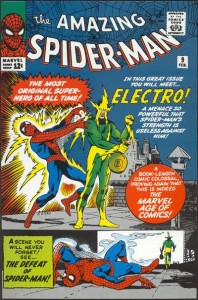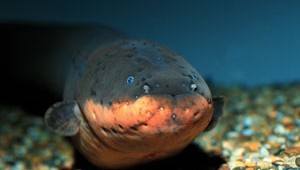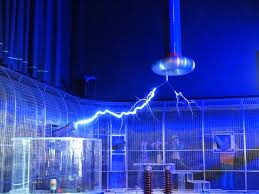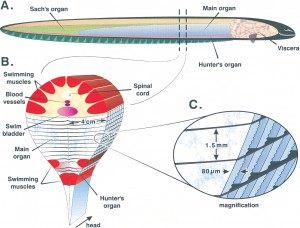It’s not like the previews are keeping it a secret – Max Dillion, a.k.a. Electro in the upcoming Amazing Spider-Man 2 gets his electrical powers from falling into a tank filled with electric eels at Oscorp’s Labs. Well, at least in part…
Watch at around 1:14 below for a little more.
Yeah, as far as origins go it’s about as good as Max’s comic book origin. That had him as the victim as a freak lightning accident that turned him into, basically, a living battery. Electro carries some weight as one of Spider-Man’s villains – he originally appeared in Amazing Spider-Man #9 (1964), and was created by the original Spider-Man team of Stan Lee and Steve Ditko. He also has a penchant for teaming up with other villains often being one of the lead members of the Sinister Six, along with Sandman, Mysterio, Doctor Octopus, the Vulture and Kraven the Hunter (a Sinister Six film, directed by Drew (Cabin in the Woods) Goddard is planned for release sometime between Amazing Spider-Man 2 and the inevitable Amazing Spider-Man 4).
Like all comic book characters, Electro has gone through dozens of changes and versions over the years. Max has changed alliances, has aged, has “youthified,” has had extreme control over his powers, has lost control of his powers, has been good, been bad, and been…gray. He was even hired by J. Jonah Jameson to defeat Spider-Man on national television. But throughout it all, Electro’s powers have stayed largely the same as seen in the movie trailers: he can shoot bursts of electricity that he stores up. In the comics, at least (we’ll see on May 2nd when the movie comes out in the U.S. if this holds true for the film version) Electro can run out of juice if he releases too much electricity over a short period of time without a chance to “recharge.” Also, judging from the trailers, movie Electro shares at least one trait with comic book Electro in that he can absorb electricity. See 1:39 in the trailer above.
In both versions, comic book and film – Electro gets his powers roughly the same way: he gets hit with a lot of electricity. A lot. More than a fork in a socket – which you should never, ever try.
While the possibilities of turning a human into an electrical generator like Electro are a bit beyond the scope of The Science Of… the biology of animals that produce electricity is right in our wheelhouse. So let’s look at the most famous of these – and part of the means by which movie Electro becomes Electro – the electric eel, Electrophorus electricus.
Electric eels make their home in South America and are most often found in the Amazon and Orinoco River basins, where they are apex predators. That means that when it comes to food, they’re at the top of the heap and have little, if anything to fear. As a result of their status, researchers and fishermen have reported electric eels swimming uncomfortably close to them if they are in the same region. They’re a mostly nocturnal freshwater species, and can live in virtually any water their habitat has to offer, from clear and pure water to muddy water with low oxygen. While not technically eels (they are actually a type of knifefish), they do have gills, but can and will gulp in air at the surface to supplement the oxygen that they can get from the water.
But to get to the meat of electric eels – yes, they do produce electricity. Straight up electricity, not some kind of biological hand-wavey “type” of electricity that only scientists who study electric eels would call electricity. Mature eels can produce between 500 – 750 volts and 1 amp of current (that’s between 500 and 750 watts of power using Power = voltage x current) for less than 2 milliseconds (0.002 seconds). That would be enough electrical power to make 5 or 6 100 W electric bulbs flicker. Or the same voltage as about 500 AA batteries lined up end to end. The jolt may not last long, but it is enough to stun small prey near the eels, allowing them to swallow the smaller fish or invertebrates whole.
The range of the eels shock is not a fixed value with voltage or even the size of the eel, but would be dependent upon both of those, along with the conductivity of the water at the site. There are unverified reports of horses in waters 20 feet away from a discharging electric eel being knocked off of its feet, but again, electric eels have a lot of legend and lore around them.
One idea to squash outright is the notion that when the eels discharge their electricity, there’s some mini lightning bolt or, well, any light at all in the water. There just isn’t. The eel convulses a little, the prey is stunned, and the show’s over. As with the length of the shock, it may not be sexy, but it gets the job done.
Comparison?
Comparison.
If you’re still stuck on something shooting off huge sparks of lightning-like electricity, you’re thinking much higher voltage. You’re probably thinking about Tesla Coil type machines, which in most cases amplify a given voltage, cranking it up to huge values. 1,000,000 volts is somewhat typical, while Nikola Tesla himself is said to have reached 100,000,000 volts (although that’s never been duplicated).
These eels – 600, 750 volts, maximum. In water.
If you took them out of water, by the way, the current wouldn’t even flow past the eels skin (which you wouldn’t want to touch, because…electricity) – the resistance of air is too high for the 600 v and 1 amp to move away from the source.
Where Do They Get the Electricity?
Electric eels’ bodies (they can grow up to 2 meters) are sharply divided internally. Looking at an electric eel in cross section, you’d see that virtually all of its vital organs are squashed into the front of its body, near its head. The remainder of its body – roughly 4/5ths of its body – is made up of three electric organs: Sach’s, main and Hunter’s. The Sach’s organ is used for electrolocation (think like dolphins or Daredevil, only with electricity) and “sight” in murky waters, while the main and Hunter’s organ are where the action’s at in regards to the electricity.
The organs are made of specialized muscle tissue which is composed of stacks of electrocytes (electricity-generating cells). In their stacks, the cells are arranged in series, while there are many stacks that are arranged in parallel. The anatomy may get blended with some electrical engineering, but the result is the same – a solid shock.
The electrocytes of the electric eels are all arranged in the same way and as a consequence, the electrical charge (600 volts and 1 amp) comes out of the head and completes the circuit by going back into the eel near the tail. Again, not some kind of special effect-like lighting bolt. It’s more of a half-circle all around the eel.
Key to the production of electricity in the electrocytes is their layout – they’re asymmetrical. The side towards the tail is smooth (and has nerves attached to it), while the side towards the head is convoluted, or has a “rougher” surface. As for why this works – we need to go back to some general physiology. All cells have a slight electrical charge to them, with the outside being more positive than the inside, which is more negative. Cell membranes have “pumps” in them – proteins that continually relocate positively charged atoms like sodium (Na+), potassium (K+), and calcium (Ca+) to the outside. In a normal cell, this resting potential would be about 0.085 volts, spread evenly throughout the cell.
But in the asymmetrical electric eel electrocyte, it doesn’t work that way. When signaled to fire by the eel’s nervous system, the smooth side opens its pumps up and lets positively charged atoms in, creating a potential difference (voltage) of 0.065 volts. This charge is in series with the 0.085 volts of potential difference and therefore, adds to it, creating a brief charge across the entire cell of 0.15 volts (0.085 v + 0.065 v). The charge is extremely short-lived, but – and this is the but that’s important – the eel has somewhere between 5,000 to 7,000 of these cells stacked up. Let’s go easy and call it at 5,000 cells. In series. Just multiply the charges: 0.15 volts x 5000 cells = 750 volts.
While biologists know that the pulse is quickly over (again, 2 milliseconds – a short eye blink is 100 milliseconds), there are plenty of mysteries that have yet to be figured out, such as how the eel’s nervous system coordinates the firing of the nerve impulses so that effectively, every cell gets the message at the same time, rather than the cells nearer the brain (front) get the signal before the tail cells. Also – reports very on the latency of repeated firings – how often and for how long the eel can fire its electrocytes. Some reports suggest (questionably) that electric eels never tire, and can keep firing continuously, while other accounts tells of fishermen on the surface continually prodding and harassing electric eels with sticks in order to exhaust the eels, which are later captured for collectors or zoos.
Safe money says they do, eventually, exhaust themselves – the electrocytes fire when excited by the neurotransmitter acetylcholine, and any linking thing’s supply of acetylcholine isn’t infinite. It’s synthesized from raw ingredients, and those raw ingredients have to be processed, and so on and so on, all the way back to the eel’s food. Sooner or later, the eel will most likely exhaust its electric ability.
By the way, if you’re thinking of getting an electric eel for an aquarium…don’t. The shocks are real, and many sources have warnings that spin small tales of possibly being shocked while working on the tank, falling in, being shocked some more by your startled eel, ultimately, not being able to surface and drowning. At zoos and large aquariums with electric eel displays, extreme caution is taken with the animals – handlers only feed the tank while wearing rubber gloves and standing on a rubber mat.
There are some sources that suggest electric eels feel their shocks (which, if they carry that particular trait over to ASM 2’s Max Dillion, would make him even more tragic), but have perhaps become desensitized to them, are insulated against them, or some combination. What is true is that electric eels experience their shocks in some way – it’s just that the “how” is unknown.
As you can figure from the above, electric eels produce the electricity they need. They can’t absorb any excess, and the effect of their short burst stays pretty close to them in the water – despite what an ElectricEel-Nado movie may one day suggest.
Is an Electric Eel in Your Future?
Finally – if we can go back to the movie for a moment, let’s indulge ourself in a question – why would Oscorp, a company that’s all about bioengineering and gene technology and splicing be interested in electric eels? Isn’t that like a completely contrived piece of nonsense?
Not really.
While this may start you down a road back to Amazing Spider-Man 2 and poor Max Dillion in that tank of electric eels and gene splicing – there have been suggestions of making artificial electrocytes based on electric eel cells, with the idea of putting them into humans.
No – the end result would not be something like this:
Get More:
2014 MTV Movie Awards, Latest Movie News
Researchers at Yale have only modeled artificial electrocytes, and while they think that the cells could be built, the really cool part is that the model that was constructed of the artificial cells suggest that the power could be tweaked upward, along with the cell’s efficiency. In other words – perhaps one day humans will have living cells inside us that produce electricity.
Why would that be a plus? As the researchers, Jian Xu and David LaVan explained, the new electrocytes could be used to power medical implants, such as retinal implants and other small, or even moderately sized prostheses or other devices needing small amounts of electricity to operate. LaVan and Xu’s models show their cells to be smaller and able to produce 28 percent more electricity than the eel’s electrocyte.
Now they just have to build it.
For More:
Ask a Naturalist: How Do Electric Eels Generate Electricity?
Researchers Design Artificial Cells That Could Power Medical Implants
Moody Institute of Science (1954 film): The Electric Eel (I)
Moody Institute of Science (1954 film): The Electric Eel (II)












